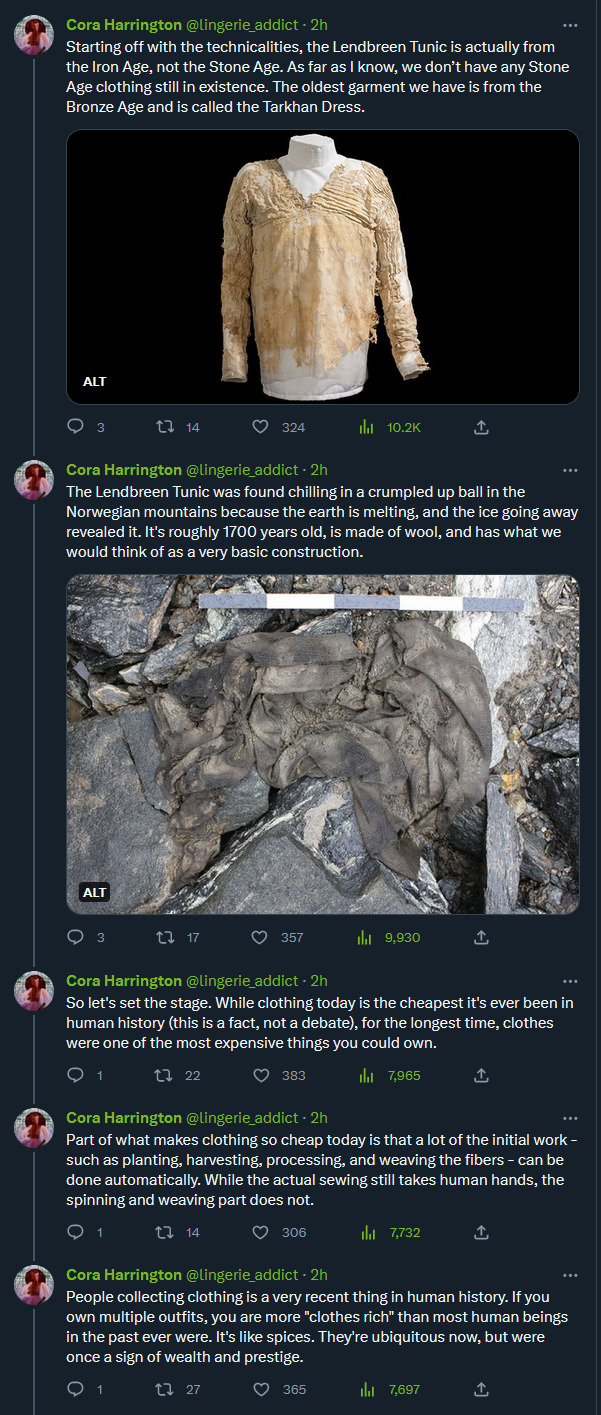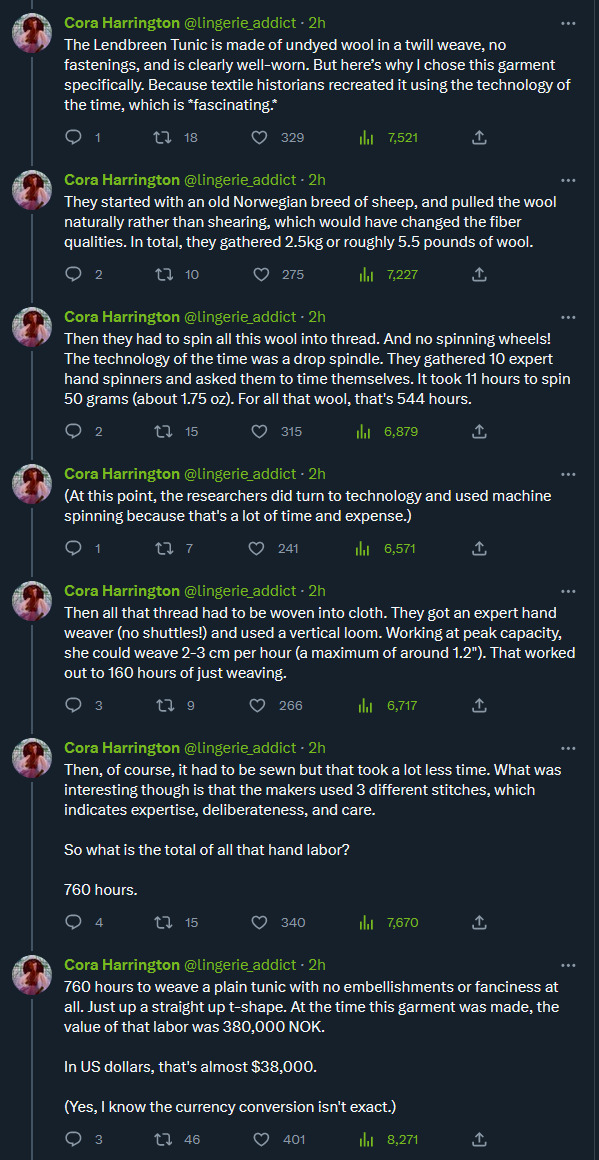"The miraculous inventiveness of man shall not be dedicated to his death, but consecrated to his life"
Last active 60 minutes ago
Don't wanna be here? Send us removal request.
Text

Here is a mural (I am told it is in Brussels) honoring Marie Curie.
If you didn’t know, during the First World War she volunteered as a radiologist at the front lines, performing vital examinations of wounded soldiers. It is thought that this, more than her experiments with radium and polonium, was the source of the radiation poisoning which ultimately killed her — in the laboratory, she observed what safety precautions she could, but in the field she often continued working long after developing skin burns.
Embrace your divine feminine energy by taking part in traditional women's hobbies & interests like experimenting with radioactive materials, developing mathematics, programming computers, piloting aircraft and practicing marksmanship.
2K notes
·
View notes
Text
Once more with feeling — the people on this planet are crazy! And in that context, I discuss possible next steps, mine (which definitely involve one of which will be Archipelacon, and may involve turning blast into a newspaper, but I also can’t rule out a panicked trans–Atlantic flight) and other people’s. Also some very welcome news from Great Britain, ridiculously beyond any reasonable time–frame for it, but welcome.
Direct link to archive recording [192 kbps MP3, 40 MB]
0 notes
Text
An intriguing diagram here, to be sure, which shows usefully how recent commitments to new nuclear energy in Britain are very little, very late. This is especially true when we consider that the electrification of transport and domestic heating is expected to double British electricity demand in the coming decades.

Britain once had a world–beating nuclear industry, and for some years could boast not only the largest fraction of nuclear electricity supply, but also the largest aggregate number of kilowatt-hours generated, of any country in the world. But all the orders for the first group of “commercial” nuclear stations, Berkeley through Wylfa, were placed before the first one started up. Then there was a pause in ordering, which seriously damaged the industry.
Part of the problem was that the nuclear industry had tooled up in response to a Government–announced programme of nuclear power, based on Calder Hall, which had both a generating capacity target and a number–of–stations target. Quite rapidly, however, the consortia formed to build the nuclear power plants found that they could increase the power output per station, at a significant decrease in the capital cost per kilowatt installed, and thus in the cost per unit sent out. As a result, they reached the capacity target much sooner than the number–of–stations target, and needed more orders to earn a return on the capital invested.
This posed a conundrum. Building nuclear stations faster than demand growth would mean closing coal stations, and ultimately coal mines. For different political reasons, neither Labour nor Conservative governments wanted to do that. In fact, the Generating Boards were actually required to build several large coal stations they did not want! And there was a reasonable reluctance to continue the rapid pace of nuclear ordering until some experience had been gained with the longer–term performance of the new technology.
That left export sales. But here, British industry was hobbled by very weak export–promotion efforts on the part of its own government, and very strong ones on the part of the US government, which wanted as many countries as possible to buy reactors which required enriched uranium. Since the USA controlled the supply of this fuel, it could dictate terms based around its ideas of non–proliferation policy. Another obstacle was a series of ham–fisted attempts at currency manipulation, which ended with the implosion of the “Sterling area”. In the end, only two plants were sold overseas, one–reactor units at Latina in Italy and Tokai–Mura in Japan.
2 notes
·
View notes
Text
It appears we will have a modest display table at Archipelacon, this year’s European Science Fiction Convention, in the exotic Åland Islands, a demilitarized zone in the Gulf of Bothnia between Sweden and Finland.
0 notes
Text
Brighton is in Britain (Blighty if you’re feeling mean), and this weekend, so am I. In this pre–recorded message, I invite you to consider the question of whether, from the viewpoint of Sir Thomas More, we may not already be living in the post–Singularity, trans–human future. Certainly the conditions of human life have been fundamentally altered since his day!
Direct link to archive recording [192 kbps MP3, 40 MB]
Supplementary Show
2025–06–13 I finish up A Snapshot in Time with a brief but interesting section entitled Future, a series of questions and answers about nuclear power safety (meant to educate the public into acceptance, which may not actually work all that well), and some brief biographies of senior Westinghouse personnel. There is a glitch halfway through, owing entirely to my error and ill–preparedness.
1 note
·
View note
Text
These are astonishing times we live in.
Our capabilities, as a civilization and even as individuals, are greater than they ever have been. And it seems some people just can’t stand that. Unlike President Kennedy and his “why not?”, they look at all we have built and achieved and shy away. They want small, they want simple, they want their world–view and their social position to be more important than planets and atoms.
They must not get what they want.
6 notes
·
View notes
Text
Why does the government want the UK to use more nuclear power?
— asks the BBC. The answer is straightforward enough. Surprisingly, it starts with the fact that the one new nuclear project started in the UK since the 1980s, Hinkley Point C, is also the most expensive in the world, coming in at a price per kilowatt of installed capacity about five times that of Barakah in the United Arab Emirates.
This high cost is partly due to a most unsuitable funding mechanism that was imposed, the so–called Contract for Difference. Because the CfD is the funding mechanism used for renewable energy projects in the UK (which generally have both shorter construction timetables, and shorter lifespans), a direct comparison is possible, and it is seen that the CfD price for new on–shore wind projects (the cheapest renewable energy in Britain) is rapidly rising toward the Hinkley Point C CfD price.
Nor does nuclear require the massive grid investments of distributed generation : new nuclear units can be built at the sites of coal–burning power stations, already hooked up to the National Grid, and connected in a thoroughly conventional way by the existing switchgear. No “smart grid” schemes of dubious reliability are required. The UK already possesses an uncommonly large amount of grid–scale storage, and feeding it (as designed) with the consistent output of nuclear plants rather than the fluctuating output of wind and solar only makes it work more economically.
In other words, if new nuclear in Britain could be built at even two or three times the price of Barakah, it would be far and away the cheapest non–carbon electricity available. And if the announced plans for shifting energy demand in home, transportation, and industry away from burning fuels and toward electricity are to be realized, very large increases in electricity supply will be required in the near future.
2 notes
·
View notes
Text
It is all too easy to lose sight of the fact that, for all the troubles of our modern world, our “Civilization and its Discontents”, the systematic application of scientific knowledge to human needs in the form of industrial technology has made the ordinary person in today’s wealthy societies wealthy beyond the dreams of past ages. Even the people of the poorer countries benefit by everything from machine–woven cloth to eyeglasses to vaccines.
All of that unprecedented prosperity depends upon the supply of energy. Controlled nuclear fission, operated on a regenerative fuel cycle, is not the only possible solution to the problem of providing that energy in sufficient quantities that everyone can fully enjoy its benefits, indefinitely into the future, but it is the most accessible means of doing so with the technology we have today. To move forward expeditiously toward the full use of this energy source is not merely a practical expedient, but a moral imperative.




@lingerie_addict has a really cool thread on ancient fashion over on twitter.
Those source links are here
cambridge.org
Youtube
ucl.ac.uk
35K notes
·
View notes
Text
We have to express admiration for all the artists here and their creations. Some of works are multiple pages, of which only the first page is shown ; clicking through will give you the rest.
If any of them particularly strikes you, do let us know. We have been considering commissioning an artist for a poster project.
1 note
·
View note
Text

Back in 1966, Britain was a world leader in civil nuclear power, and it was considered enough of a distinctively British technology to take the highest–denomination spot in an issue of postage stamps dedicated to that theme.
Judging by the announcement earlier this week, and the explanatory piece run by the BBC, there is a long way to go to get back to that point, if they ever can.
3 notes
·
View notes
Text

"The waning gibbous Moon is pictured above Earth's horizon as the International Space Station was orbiting 257 miles over the Celebes Sea off the coast of Malaysia."
Date: June 6, 2023
NASA ID: iss069e018196
99 notes
·
View notes
Text


A peek at some new acquisitions.
2 notes
·
View notes
Text
No matter how many times I say it, it keeps being true : international air travel is for the birds! But at least the 6 line of the Munich subway is back in operation. Also I once again criticize the mindset that “nobody ever changed the world working 40 hours a week” — design and engineering decisions made by overworked people in understaffed offices are likely to be bad, or at best, less than good.
Direct link to archive recording [192 kbps MP3, 40 MB]
Supplementary Show
2025–06–03 More from A Snapshot in Time, mostly an extended description of the corporate structure of Westinghouse PWRSD. Next time we will get to some more interesting material!
2 notes
·
View notes
Photo
Space Shuttle mid–deck lockers are visible on the right, and if I’m not completely mis–remembering how this works, you can sort of see how the seats (used for launch and landing) are stowed to clear the area while on orbit.

Flying Floopy…
29K notes
·
View notes
Text
The present US government talks about being pro–space and pro–nuclear, but (unsurprisingly) its actions are far from supporting that.
Issuing Executive Orders to the national laboratories, for instance, telling them to go ahead with new test reactors and other facilities, for instance, is all very well and good, but what exactly does it accomplish when you have slashed those laboratories’ budgets and discharged many of their staff?
Trump's NASA budget will kill nuclear space propulsion research if implemented, just a few years after we finally got it started again. Sorry to get so political on here, but this is not an America first decision. Trump is once again sabotaging America's leadership in space on flimsy, short-sighted grounds.
The article is pretty long but good, echoing a lot of the complaints I have with this decision. Cutting nuclear space propulsion (both thermal and electric) research is a terrible idea when the NASA budget cuts are ostensibly in aid of getting astronauts to Luna and Mars over all other priorities. Luna we can do with chemical rockets, but doing Mars on chemical is quite challenging:
Last week, SpaceX founder Elon Musk outlined how the company plans to land its first Starships on Mars. His roadmap includes more than 100 cargo flights to deliver equipment to produce methane and liquid oxygen propellants on the surface of Mars. This is necessary for any Starship to launch off the Red Planet and return to Earth. "You can start to see that this starts to become a Rube Goldberg way to do Mars," Polzin said. "Will I say it can't work? No, but will I say that it's really, really difficult and challenging. Are there a lot of miracles to make it work? Absolutely. So the notion that SpaceX has solved Mars or is going to do Mars with Starship, I would challenge that on its face. I don't think the analysis and the data bear that out."
Once again, we're going all-in on Starship, even though it's an unproven design servicing a...questionable architecture. Maybe it will work, maybe it won't—but the US government needs a competitive launch market. This strategy does the opposite.
NASA's nuclear power program is not finished. The Trump administration's budget proposal calls for continued funding for the agency's fission surface power program, with the goal of fielding a nuclear reactor that could power a base on the surface of the Moon or Mars. Lockheed and BWXT, the contractors involved in the DRACO mission, are part of the fission surface power program.
At least kilopower will survive...for now. Walking away from that would have been a true disaster.
Fun fact: Jared Isaacman was openly in favor of nuclear rockets, and Trump just rescinded his nomination for NASA administrator for rather vague reasons. It's not inconceivable that pushback over decisions motivated Trump to do so. After all, loyalty seems to be the only virtue that President Trump actually values. He certainly doesn't value American leadership and preeminence on the world stage, or he wouldn't be going to such length to hamstring the space program.
Congress could end this insanity, easily. But for that, a critical number of Republicans would have to break with Trump, and such an act of disloyalty could be career-ending. So, in all likelihood, the Make America Great Again party will succeed in preventing exactly that!
35 notes
·
View notes
Text
This is adorable.

Zero Gravity Indicators: Plushies in Space!
What are zero gravity indicators?
Did you know that some astronauts bring stuffed animals with them on their journeys to space? A zero gravity indicator (ZGI) is a plushie that is brought aboard spacecraft to demonstrate when the astronauts have reached the weightlessness of space. Even though the astronauts are strapped in their seats, the plushie will float — and viewers of the livestream will know they’ve reached space! Read on to learn about some of the plushies astronauts have taken with them to space.
Giraffiti

NASA astronaut and Artemis II commander Reid Wiseman brought a very special ZGI to the International Space Station: a toy giraffe named Giraffiti. Wiseman’s mother gifted Giraffiti to his oldest daughter when she was born. When Wiseman embarked on his first mission to space, his kids gave him Giraffiti to take with him to space.
Dinosaur

NASA astronaut Karen Nyberg made a stuffed dinosaur toy by sewing together scraps of food-packaging liners and a T-shirt. Although this dinosaur toy was not an official zero gravity indicator that didn’t stop it from floating around the International Space Station and being very cute for the cameras!
8-Ball

NASA astronaut and Artemis II mission specialist Christina Koch brought a plush 8-ball toy with her during her stay aboard the International Space Station in 2019. The toy represented the Astronaut Class of 2013, which was affectionately called the “8-balls” because of its eight members. Both NASA astronauts Nick Hague and Jessica Meir, pictured here, were members of this class.
Crane
NASA's SpaceX Crew-10 mission astronauts chose a plush origami crane as their zero gravity indicator because they are all pilots and grew up building paper airplanes. The crane is also a symbol of peace.
Cheburashka and Chimpo
youtube
English captions are available for the video.
When NASA astronaut Frank Rubio flew to the International Space Station in 2022, his cosmonaut crewmates brought aboard a stuffed animal named Cheburashka. Rubio also carried a small stuffed animal in his pocket named Chimpo. Chimpo was a stuffed animal that Rubio’s children had for almost 20 years before giving it to Rubio for him to bring aboard his flight.
Snoopy

Snoopy hitched a ride around the Moon aboard the Orion spacecraft during the Artemis I mission in 2022. Although this mission didn’t have astronauts, Snoopy was joined by a manikin named Moonikin Campos who was used to measure vibrations inside the capsule. NASA has shared an association with Snoopy since the Apollo era, when Charles M. Schulz Schulz created comic strips of Snoopy on the Moon, capturing public excitement about America’s achievements in space.
What would you take with you to space?
Now it’s your turn! People of all ages from all over the world have the opportunity to design the zero gravity indicator for the Artemis II mission around the Moon. Should the astronauts’ plush companion have wings? Scales? What would you like to see floating around the Orion spacecraft? Check out the Moon Mascot challenge to learn more! Submissions are due June 16, 2025.
3K notes
·
View notes
Text
Looking realistically at the present world situation may not be good for one’s health. It certainly isn’t popular. I give a bit of an after–action report from last week, and try to contrast the Canadian (CNSC) and US (NRC) systems of nuclear–energy regulation. Neither is as good as it could be, but the CNSC model probably works better in practice. And I interrogate the possibility that the Law of Unintended Consequences may be expected, occasionally, to produce unintended benefits.
Direct link to archive recording [192 kbps MP3, 40 MB]
Supplementary Show
2025–05–30 More of A Snapshot in Time, largely a description of the Pressurized Water Reactor Nuclear Steam Supply System, interlarded with extensive explanations from me.
1 note
·
View note